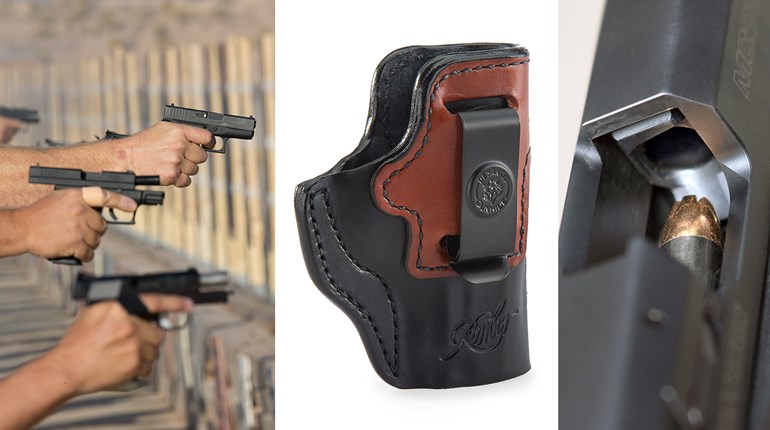
While imitation may be the sincerest form of flattery, as seen by the number of firearm manufacturers that saturate the market with contemporary clones of highly popular guns, it shouldn't overshadow product development and innovation/evolution. Many modern offerings contain subtle tweaks and design changes in an effort to make good guns even better. Sadly, despite the hand-and-hand relationship of handgun and holster, signs of innovation/evolution aren’t nearly as prevalent within another clone-laden market: that pertaining to holsters.
Case in point: one can easily suggest the holsters on the Western frontier took a major evolutionary step the with Hermann H. Heiser’s spring-retention system, a concept that eventually trickled down into the later designs of J.M. Bucheimer, Brauer Brothers, Lewis Leather Company and Berns-Martin. That same degree of vicissitude wasn’t seen again until the 1970s with the introduction of Roy Baker’s Original Pancake Holster, in the 1980s with the advent of the nylon holster, Ken Null’s City Slicker and most recently with the hybrid marriage of leather and Kydex offered by the late Mark Craighead of Crossbreed Holsters.
Concerning shoulder holsters, however, the list is even fewer. Aside from Berns-Martin’s multi-purpose Triple Draw, which, in addition to carrying a revolver in an upside-down fashion, it was also capable of ambidextrous belt carry. It wasn’t until at least two decades later that shoulder-holster design was taken a step father with Chic Gaylord’s radically different Blue Streak, a shoulder rig that oriented the gun to ride straight up and down with a snap between the back of the trigger guard and front of the grip frame. To draw the revolver, one simply placed a hand on the grip and pull forward. The motion pivoted the pistol butt downward—which re-oriented the pistol so it was perpendicular to the ground— and allowed the pistol to be drawn (and even fired) while still in the holster, making the Blue Steak the forerunner to the modern horizontal shoulder holster that’s so popular in TV and films today. While there’s little doubt programs like “The Greatest American Hero,”“Miami Vice” and the “Die Hard” franchise of films served as excellent forms of product placement for holsters like Alessi Holster’s Bodyguard, Ted Blocker’s Lifeline Shoulder Rig, and Galco’s Miami Classic, the exposure ultimately served to catapult the horizontal shoulder holster to the pop culture icon it is today.
As a professional gunwriter and physically disabled concealed-carry licensee, I’m quite familiar with and equally found of the aforementioned holsters—having owned/relied upon, and worn each for countless hours as part of my daily carry complement over the years. Unfortunately, recent bouts of chronic back and shoulder pain resulted in me relying significantly less on my favorite mode of carry. Results from MRIs and X-rays revealed the pain stemmed partially from acute arthritis and degenerative disc disease in my cervical, thoracic and lumbar vertebrae of my spine.
Thankfully, not long ago I learned of another manufacturer that has taken the horizontal shoulder-holster concept supposedly to the next level that features ergonomic enhancements that may allow me to resume this preferred mode of carry. I decided to contact the company and request one for review. What I discovered was surprising. After an hour of wearing the Andrews Custom Leather Monarch Shoulder Rig the first thing I noticed was significantly less pain at the base of my neck and the top of my shoulders, and I soon learned why. Company owner Sam Andrews’ passion for making holsters began when he was a teenager and carried over into adulthood and a career in law enforcement. Though the career choice was brief, it afforded Andrews the opportunity for his hobby of holster-making to cross over into the law enforcement realm—allowing him to make holsters for his fellow officers—and receive invaluable real-world feedback. After leaving law enforcement, Andrews began making holster full time, and he’s been doing so for more than four decades.
What’s the secret to the Monarch’s comfort? According to Andrews, most similar holsters on the market are uncomfortable to wear for extended periods and tend to restrict one’s movement. The product gets its name from the harness’ swiveling Monarch butterfly-shaped, connector plate. Swivels at the top of the plate are spaced farther apart at the top than on the bottom of the plate, which serves a dual purpose of positioning the plate between the shoulder blades for greater comfort while preventing it from rubbing one’s neck or creating unnecessary pressure over the spine. (For those with shoulders of smaller width, the butterfly plate is designed to be inverted for greater comfort, or you can select Andrews’ “Y” harness as an alternative.)

Straps that comprise the harness are wider than competing models, which serves as a means of equally distributing the weight throughout the system. By optimizing the load between the handgun and spare ammunition, lessens fatigue so the system can be worn longer. But, effective weight distribution is only part of what defines a good shoulder holster. It must possess the means to anchor the pistol and ammunition to the body—to minimize its components from flopping around unnecessarily—yet without affecting one’s movement.
As an alternative to traditional tie-downs, which Andrews considers a detriment due to their inherent tendency to restrict maneuverability, the Monarch Shoulder System features a lower-back strap that closes the harness off on a third side, like a vest. This prevents the holster from ‘swinging’ while leaning forward or drawing the pistol, and keeps both sides of the holster securely tucked in close to the body. Such a design fosters freedom of movement without sacrificing one’s natural range of motion. The result is a shoulder holster that moves with the body—rather than one that moves on its own—for greater concealment. Each end of the harness loops into two metal keepers on the ammo carrier and holster, while the lower-back strap connects to the system via D-rings.

Available for small- or large-frame semi-automatic pistols and revolvers, the Monarch’s holster is skeletonized, meaning the body of the holster doesn’t end at the muzzle. Unlike its competitors, the interior is lined with suede, which, in addition to reportedly preserving the pistol’s finish, it also covers the backside of metal hardware (such as snaps) that could potentially mar a handgun’s finish. The mouth of the holster contains a thumb break with a directional snap for added security. In the event the thumb break is hit by accident, an adjustable screw and grommet spans the underside of the holster to provide greater retention, if needed. There’s even a belt loop on the back of the holster for those who wish to wear the holster without the harness.
Whereas the offside of most horizontal shoulder holsters is typically used for carrying spare ammunition in the form of a single- or double-magazine pouch (or a double “dump” or speedloader pouch for a revolver) the Monarch system offers the same benefit—but with numerous options designed for greater versatility to suit an array of purposes, such as a handcuff case for law enforcement officers. In addition, the selection of double magazine pouches can hang horizontal or vertically, and can include snap closures or a friction fit via tension screws. For those who subscribe to the “more is better” philosophy, ammo carriers capable of holding five or even 10 magazines are also available. Andrews also offers combination ammunition/accessory pouches that consist of a second holster for an identical pistol (or a smaller backup gun, like a J-frame) along with two single horizontal magazine pouches, mounted directly below for your primary sidearm. Need an extra edge? Sheathes for popular fixed-blade fighting knives such as the Cold Steel Tanto and the Gerber Mk I are another popular addition—the sheath, which is removable, mounts directly behind the magazine pouch and hangs inverted—the knife retained by a pull-through snap that secures around the guard. The modularity present in this shoulder rig is limited only by your imagination—and your budget.

During the one-week period when I wore the Monarch Shoulder Rig with a wide array of 1911s from the Boyd Bunker on a daily basis, I’m happy to report enjoyable findings. Without question, this was largely due to the design of the harness, which helped me to once again enjoy my favorite mode of carry—from either my electric scooter or while using my crutches—without affecting/impeding my balance or movement. Most important, the combined weight from the gun and holster didn’t aggravate/irritate pain from my ailing back and neck. Once the tension screws in the holster and magazine carrier were adjusted, presentations and holstering proved quite intuitive. The absence of traditional tie-downs became beneficial in two ways: First, when sizing the rig, it allowed the holster and magazine pouch to be positioned higher under the armpit to minimize weight of the pistol and ammo from shifting. Second, having the lower back strap in place kept the holster close to my body and prevented it from swinging forward as my 1911 cleared leather.
Thanks to the tension screws being used to retain spare magazines, reloads were a breeze—my diminished fine motor skills notwithstanding—a slight tug was all that was needed to free magazines (instead of fumbling with a snap).

No matter what type of pistol you carry for personal protection, you owe it to yourself to pair it with one of the most comfortable and meticulously crafted shoulder holsters of all time. From its ergonomic enhancements to its customizable multitude of modular features, the Andrews Monarch Shoulder System may have evolved from the popular horizontal shoulder holster, but it takes the system to the next generation of concealed-carry licensees.
(Pricing starts at $275 for holster, harness and double-ammo carrier.)






































